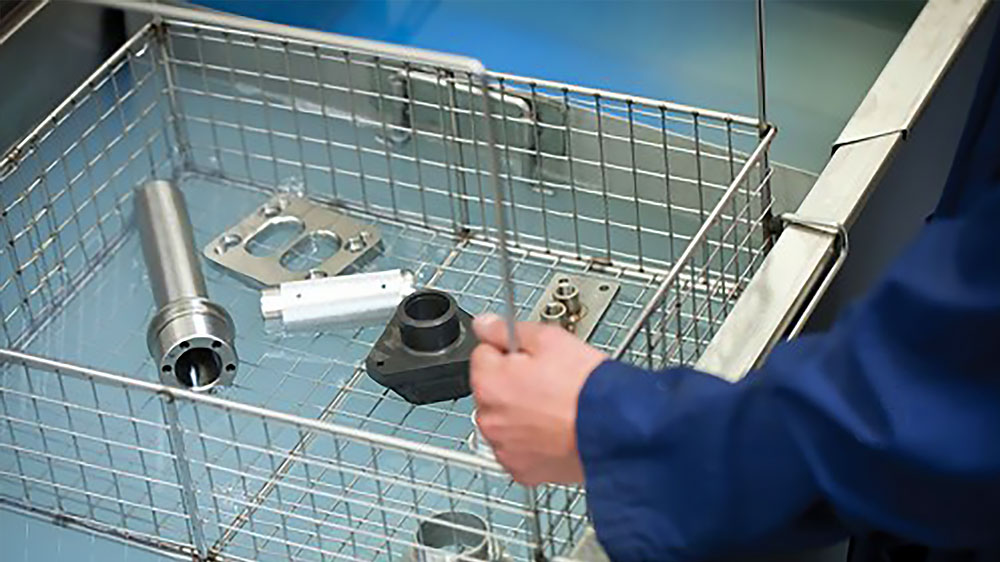The cleanliness of parts is critical to ensuring product quality and performance. In industries like aerospace, automotive, electronics, and medical devices manufacturers are subject to strict cleanliness standards and environmental regulations. One key aspect that directly affects cleanliness is the proper maintenance and monitoring of industrial parts cleaning baths. Over time, cleaning baths can become contaminated with various substances that reduce their effectiveness and compromise product quality. Let’s explore why monitoring these cleaning systems is vital and the types of contaminants that can accumulate over time.

Reasons to monitor industrial cleaning baths
Ensures Optimal Cleanliness
The primary purpose of a parts cleaning bath is to remove contaminants like oils, particulates, and residues. However, if the bath itself becomes contaminated, it loses its ability to clean effectively. Regular monitoring ensures that the bath is functioning at its peak, maintaining the high cleanliness standards required in industries where precision is essential. For example, in the aerospace industry, even the smallest contamination can lead to product failure.
Prevents Cross-Contamination
Over time, cleaning baths can become saturated with contaminants, which can redeposit on parts during cleaning. This cross-contamination can lead to product rejections, wasted resources, and delays in production. Monitoring allows for timely intervention, preventing the accumulation of contaminants that could compromise parts quality.
Improves Process Efficiency
By regularly checking the condition of the cleaning bath, manufacturers can optimize their cleaning processes. This reduces the need for frequent bath changes, extending the useful life of the cleaning solution and lowering operating costs. In addition, monitoring allows for the precise adjustment of cleaning agents and chemicals, ensuring effective cleaning without overuse.
Enhances Product Reliability
Clean parts lead to reliable products. In high-precision manufacturing environments, even a small amount of residue or particulate left on a component can cause malfunctions, reduce product lifespan, or lead to safety issues. Proper monitoring ensures that parts leave the cleaning process free from harmful contaminants, directly contributing to the reliability and performance of the final product.
Compliance with Industry Standards
Many industries are subject to strict cleanliness regulations and standards, such as ISO 16232 for the automotive industry or the standards required for medical devices. Regular monitoring of cleaning baths ensures compliance with these regulations, avoiding fines, production shutdowns, or recalls that can be both costly and damaging to a company’s reputation.
Reduces Downtime
A cleaning bath that isn’t properly monitored will eventually lose its effectiveness, leading to unexpected production stoppages as parts may need to be re-cleaned or cleaning systems overhauled. Proactive monitoring helps avoid this unplanned downtime, keeping production lines running smoothly and efficiently.
Removing contamination off cleaning and rinsing baths in the industrial parts cleaning ensures a long bath operation time and high parts cleanliness. The SITA ConSpector can measure the bath contamination in cleaning and rinsing baths directly on the shop floor within a few seconds.
Types of Contamination That Build Over Time
As cleaning baths are used, various contaminants can accumulate, reducing their effectiveness. Here are the common types of contamination that can build up:
Oils and Grease
Source: These contaminants originate from lubricants, cutting fluids, and other oils used in manufacturing processes.
Impact: If not removed effectively, oils and grease can form films on parts, preventing proper adhesion of coatings or causing parts to fail in operation.
Particulates and Solids
Source: Metal shavings, dust, and debris from parts can accumulate in the cleaning bath.
Impact: These particles can redeposit on parts, leading to defects, mechanical failure, or compromised product performance.
Surfactant Breakdown Products
Source: Surfactants, used to break down oils and dirt, can degrade over time.
Impact: Degraded surfactants reduce cleaning efficiency and may leave residues on parts, affecting cleanliness.
Chemical Contaminants
Source: Chemical reactions between cleaning agents and contaminants or the breakdown of cleaning chemicals can introduce new contaminants.
Impact: Changes in the chemical composition of the bath can lower its cleaning power, cause corrosion, or leave unwanted residues.
Water Hardness Minerals
Source: Hard water can introduce calcium, magnesium, and other minerals into the bath.
Impact: These minerals can form deposits on parts, impacting the quality of the surface finish and causing further processing issues.
Biofilm and Microbial Growth
Source: In water-based cleaning baths, bacteria or microorganisms may proliferate if the system isn’t properly maintained.
Impact: Biofilms can form on both the parts and the bath equipment, leading to contamination and potential hygiene risks in industries like pharmaceuticals or food processing.
Residual Cleaning Agents
Source: Inadequate rinsing or overuse of cleaning chemicals can result in a buildup of cleaning agents in the bath.
Impact: This can leave stains, lead to corrosion, or cause problems in subsequent manufacturing processes like painting or welding.
Emulsified Contaminants
Source: Oil and water mixtures that become emulsified in the cleaning bath.
Impact: These emulsions reduce the bath’s cleaning ability, leaving contaminants on parts and potentially causing failure during operation.
Metal Ions
Source: Metal ions released from parts being cleaned or as a result of chemical reactions in the bath.
Impact: These ions can deposit on cleaned parts or disrupt the chemical balance of the bath, reducing its effectiveness.
Organic Contaminants
Source: Natural oils, adhesives, sealants, or other organic substances from the parts being cleaned.
Impact: Organic residues can interfere with processes like bonding, coating, or painting, leading to quality control issues.
Effective monitoring of industrial parts cleaning baths is essential for maintaining product quality, optimizing cleaning processes, and ensuring regulatory compliance. Over time, contaminants like oils, particulates, and chemical byproducts accumulate, reducing the bath’s cleaning power. By staying vigilant and conducting regular checks, manufacturers can ensure their cleaning systems continue to operate at peak efficiency, leading to cleaner parts, higher product reliability, and lower operating costs.

